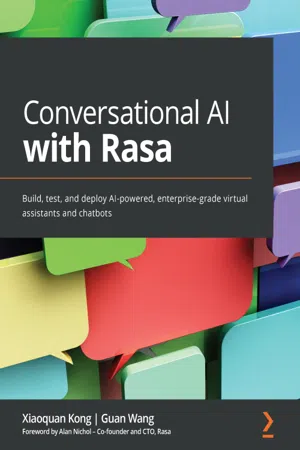
- 264 pages
- English
- ePUB (mobile friendly)
- Available on iOS & Android
Conversational AI with Rasa
About this book
Create next-level AI assistants and transform how customers communicate with businesses with the power of natural language understanding and dialogue management using RasaKey Features• Understand the architecture and put the underlying principles of the Rasa framework to practice• Learn how to quickly build different types of chatbots such as task-oriented, FAQ-like, and knowledge graph-based chatbots• Explore best practices for working with Rasa and its debugging and optimizing aspectsBook DescriptionThe Rasa framework enables developers to create industrial-strength chatbots using state-of-the-art natural language processing (NLP) and machine learning technologies quickly, all in open source.Conversational AI with Rasa starts by showing you how the two main components at the heart of Rasa work – Rasa NLU (natural language understanding) and Rasa Core. You'll then learn how to build, configure, train, and serve different types of chatbots from scratch by using the Rasa ecosystem. As you advance, you'll use form-based dialogue management, work with the response selector for chitchat and FAQ-like dialogs, make use of knowledge base actions to answer questions for dynamic queries, and much more. Furthermore, you'll understand how to customize the Rasa framework, use conversation-driven development patterns and tools to develop chatbots, explore what your bot can do, and easily fix any mistakes it makes by using interactive learning. Finally, you'll get to grips with deploying the Rasa system to a production environment with high performance and high scalability and cover best practices for building an efficient and robust chat system.By the end of this book, you'll be able to build and deploy your own chatbots using Rasa, addressing the common pain points encountered in the chatbot life cycle.What you will learn• Use the response selector to handle chitchat and FAQs• Create custom actions using the Rasa SDK• Train Rasa to handle complex named entity recognition• Become skilled at building custom components in the Rasa framework• Validate and test dialogs end to end in Rasa• Develop and refine a chatbot system by using conversation-driven deployment processing• Use TensorBoard for tuning to find the best configuration options• Debug and optimize dialogue systems based on RasaWho this book is forThis book is for NLP professionals as well as machine learning and deep learning practitioners who have knowledge of natural language processing and want to build chatbots with Rasa. Anyone with beginner-level knowledge of NLP and deep learning will be able to get the most out of the book.
Frequently asked questions
- Essential is ideal for learners and professionals who enjoy exploring a wide range of subjects. Access the Essential Library with 800,000+ trusted titles and best-sellers across business, personal growth, and the humanities. Includes unlimited reading time and Standard Read Aloud voice.
- Complete: Perfect for advanced learners and researchers needing full, unrestricted access. Unlock 1.4M+ books across hundreds of subjects, including academic and specialized titles. The Complete Plan also includes advanced features like Premium Read Aloud and Research Assistant.
Please note we cannot support devices running on iOS 13 and Android 7 or earlier. Learn more about using the app.
Information
Section 1: The Rasa Framework
- Chapter 1, Introduction to Chatbots and the Rasa Framework
- Chapter 2, Natural Language Understanding in Rasa
- Chapter 3, Rasa Core
Chapter 1: Introduction to Chatbots and the Rasa Framework
- What is ML?
- Introduction to NLP
- Chatbot basics
- Introduction to the Rasa framework
Technical requirements
What is ML?
- Software development: Product managers and software engineers work together to understand business requirements and transform them into detailed business rules. Then, software engineers write the code to transform business rules into computer programs. This stage is shown as process 1 in the following diagram.
- Software usage: Computer software transforms users' input to output. This stage is shown as process 2 in the following diagram:

- Software development: The ML algorithm infers hidden business rules by learning from training data and encodes the business rules into models with lots of weight parameters. Process 1 in the following diagram shows the data flow.
- Software usage: The model transforms users' input to output. In the following diagram, process 2 corresponds to this stage:

Supervised learning (SL)

Table of contents
- Conversational AI with Rasa
- Foreword
- Preface
- Section 1: The Rasa Framework
- Chapter 1: Introduction to Chatbots and the Rasa Framework
- Chapter 2: Natural Language Understanding in Rasa
- Chapter 3: Rasa Core
- Section 2: Rasa in Action
- Chapter 4: Handling Business Logic
- Chapter 5: Working with Response Selector to Handle Chitchat and FAQs
- Chapter 6: Knowledge Base Actions to Handle Question Answering
- Chapter 7: Entity Roles and Groups for Complex Named Entity Recognition
- Chapter 8: Working Principles and Customization of Rasa
- Section 3: Best Practices
- Chapter 9: Testing and Production Deployment
- Chapter 10: Conversation-Driven Development and Interactive Learning
- Chapter 11: Debugging, Optimization, and Community Ecosystem
- Other Books You May Enjoy